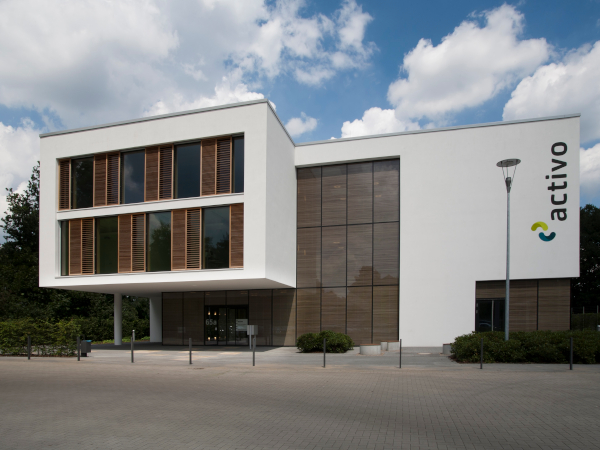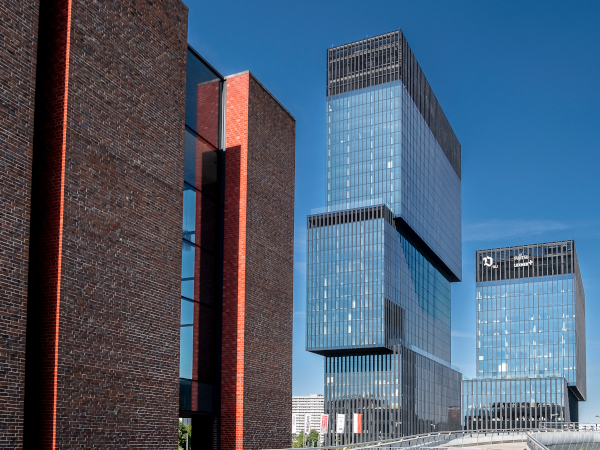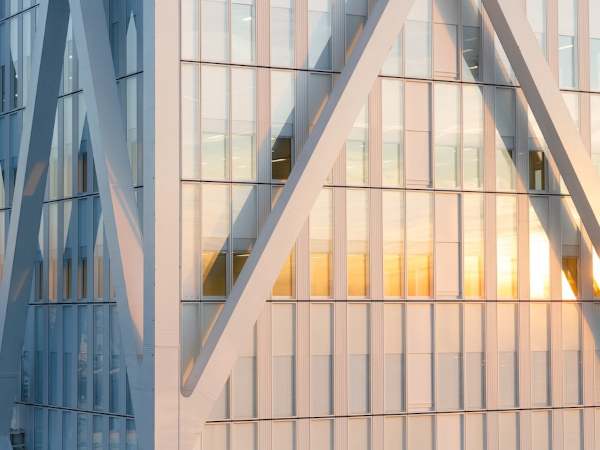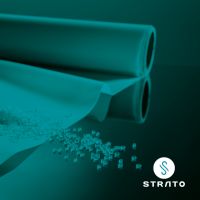Date: 7 May 2007
/strong>
Glass opens up a room and creates transparency and depth. This is why the architects from Billings Design Associates (BDA) wanted a highly transparent office complex with a unique outer shell for Grand Canal Square No. 1, located in the southern dockland of Ireland’s capital of Dublin. This building was to provide a contrast to the massive neighboring buildings in terms of light transmittance. To achieve this, the facade was glazed with Amiran® anti-reflective glass.
However, its unique character results from the vertical glass fins on the external face. Depending on where one might be standing, the background and the incidence of light, different colorful effects can be observed. The reason is that several optical interference layers were applied to the surface of the color effect glass Narima®, using a dip-coating technique. As Neil Murphy, a design consultant at BDA, explains: ”We were impressed with the variety of effects this glass created as an esthetic element in the Norddeutsche Landesbank building in Hanover.” Thorough independent testing also confirmed that Narima® would offer lasting durability for this new application.
As this illustrates, if glass is used with highly modern processing techniques or integrated into system solutions, it opens up new design possibilities for architects. To develop these, SCHOTT relies on nearly a century of technical know-how on glass and modern technologies.
”SCHOTT now offers architects and investors a fascinating variety of sophisticated glazing solutions for all kinds of architectural challenges,” explains Patrick Coppée. Thanks to his international experience with projects, he integrates the expertise of all business units into strategies for developing the business.
Around the world with Amiran®  One can see how technology can promote the use of glass in architecture by taking a look at Amiran®, an ”evergreen” for many years. Inside the visible wavelength region, this flat glass is almost completely free of reflections. It can also be processed into laminated or toughened safety glass or included in insulated units.
One can see how technology can promote the use of glass in architecture by taking a look at Amiran®, an ”evergreen” for many years. Inside the visible wavelength region, this flat glass is almost completely free of reflections. It can also be processed into laminated or toughened safety glass or included in insulated units.
At the port in the Scottish city of Aberdeen, the top floor of the »Marine Operations Centre« that recently went into operation to direct traffic is glazed with Amiran® anti-reflective glass to provide a clear view of shipping movements in and out of this busy harbor. The award-winning design of the building is based on the tradition of Scottish lighthouses.
In Athens, the lobby of the first class Royal Olympic Hotel at the foot of the Acropolis was also glazed with Amiran® at the beginning of 2006. Since then, one can view the Greek capital’s most famous landmark without being disturbed by annoying reflections. And in the neighboring country of Turkey, Amiran® made a stop at Nurus in Istanbul. This internationally-renowned manufacturer of office furniture had the facades of its exhibition rooms equipped with 80 square meters of anti-reflective glass. Amiran® also accompanied a remarkable renaissance in Germany. In September of 2006, the historic Green Vault in the Royal Palace in Dresden opened its gates again, after having been closed for some time. Selections of the some 3,000 artworks are on display inside showcases made of anti-reflective glass. The world-renowned treasure chamber was built by August the Strong in the 18th century and destroyed by bombs during the war in 1945.
Pyran® with a star
When it comes to the use of fire resistant Pyran® glass inside the spectacular Mercedes-Benz Museum that opened in Stuttgart, Germany, in May of 2006, the highest demands for both technology and design had to be met. The architecture of the aluminum-silver building that rises up 48 meters sets standards. The Dutch architects around Ben van Berkel selected the shamrock ribbon, an infinite figure, as the point of origin. Mercedes comes to life inside, both as a brand and a legend.
In the light of the 700,000 visitors expected each year, safety is also of importance for this collection of milestones in the history of the automobile. Pyran® S was selected to perform the challenging glazing inside the museum, in part as glass that prevents falling. This fire resistant glass retains its transparency, even under severe thermal stress. The design was equally challenging. The Pyran® glazing 50 meters in length between »Round Tour of the Legend« and the event area was executed as a frameless butt joint construction without any disturbing pillars. Screen printing was then applied to enhance its appearance.
10,000 floating points of light  Glass can also be put to use in completely new lighting applications. Welcome to »LightPoints«, a product from lif-GmbH (light, innovation, future), a German company that SCHOTT has invested in. The LED technology bluffs with its light sources inside glass that appear to receive their power invisibly. The ingenious thing about them is that a transparent metallic oxide layer turns these panes into conductors. A PVB (polyvinyl butyral) laminate holds the coated glass, the LEDs and a second protective glass pane together permanently. This laminate even satisfies legal regulations for glazing secured by linear supports and individual points. In fact, »LightPoints« have been approved for use in indoor and outdoor applications, such as fall prevention and overhead glazing. The »Mall of Emirates« in Dubai, where »LightPoints« illuminate a showcase facade in one of the world’s most exclusive shopping centers, was one of the first customers. The colorful points of light can also be found glowing inside the U.S. internet portal company Yahoo’s administrative building in Burbank, California. In October of 2006, the shopping mall »La Maladière« opened in Neuchâtel, Switzerland, with 10,700 LEDs in white, blue and red distributed along the glass balustrades and the elevator. A pulsating play of light takes place every hour. ”The appropriate choreography can be set and programmed individually using our specialized software,” explains Rolf A.O. Schneider from lif. »LightPoints« have received numerous awards, including the coveted iF Award in Gold in the Material category.
Glass can also be put to use in completely new lighting applications. Welcome to »LightPoints«, a product from lif-GmbH (light, innovation, future), a German company that SCHOTT has invested in. The LED technology bluffs with its light sources inside glass that appear to receive their power invisibly. The ingenious thing about them is that a transparent metallic oxide layer turns these panes into conductors. A PVB (polyvinyl butyral) laminate holds the coated glass, the LEDs and a second protective glass pane together permanently. This laminate even satisfies legal regulations for glazing secured by linear supports and individual points. In fact, »LightPoints« have been approved for use in indoor and outdoor applications, such as fall prevention and overhead glazing. The »Mall of Emirates« in Dubai, where »LightPoints« illuminate a showcase facade in one of the world’s most exclusive shopping centers, was one of the first customers. The colorful points of light can also be found glowing inside the U.S. internet portal company Yahoo’s administrative building in Burbank, California. In October of 2006, the shopping mall »La Maladière« opened in Neuchâtel, Switzerland, with 10,700 LEDs in white, blue and red distributed along the glass balustrades and the elevator. A pulsating play of light takes place every hour. ”The appropriate choreography can be set and programmed individually using our specialized software,” explains Rolf A.O. Schneider from lif. »LightPoints« have received numerous awards, including the coveted iF Award in Gold in the Material category.
Fiber optic illumination crowns cultural heritage
Every evening until midnight, a lighting installation sets the stage for one of the most famous medieval structures in France: the Cathedral of Notre-Dame in Reims. Kings were crowned over centuries at this UNESCO world cultural heritage site.
Now more than 1,100 fiber optic light points from SCHOTT illuminate the artistic reliefs and sculptures with subtle light and present every detail in an impressive way. To achieve the best possible effect for these masterpieces, MC2, a SCHOTT customer for many years, designed a clever glass fiber optical lighting solution, as well as specialized optical lenses and filters, positioning each one individually on the cathedral front. Lamp change and maintenance of the lighting system are simple, because all of the nearly 100 light sources are located in accessible places inside the building. The lighting components from Thorn Lighting were installed by Cegelec.
Exemplary solar architecture in New York The solar roof of the overground subway station Stillwell Avenue in Brooklyn, New York, can be considered futuristic in terms of both its architecture and its use of energy. Here, 2,800 thin-film solar modules make up a 5,500 square meter roof known to be the largest photovoltaic (PV) installation in the famous metropolitan city. This is one example of the emerging discipline of solar architecture, in which the integration of thin-film modules into buildings will play a key role. They contain a substance that reacts to the sun and is released onto the glass in thin layers. This means the module can be designed in numerous ways and is provided in laminated form as an overhead construction to meet safety standards.
The solar roof of the overground subway station Stillwell Avenue in Brooklyn, New York, can be considered futuristic in terms of both its architecture and its use of energy. Here, 2,800 thin-film solar modules make up a 5,500 square meter roof known to be the largest photovoltaic (PV) installation in the famous metropolitan city. This is one example of the emerging discipline of solar architecture, in which the integration of thin-film modules into buildings will play a key role. They contain a substance that reacts to the sun and is released onto the glass in thin layers. This means the module can be designed in numerous ways and is provided in laminated form as an overhead construction to meet safety standards.
”The unique thing about PV glass used as a roofing surface is that it can take on more than one function,” explained Gregory Kiss from the New York based architectural firm to the press. The semi-transparent PV modules at Stillwell provide shade, yet produce 250,000 kilowatt hours of electricity each year. Here, design turns into a cost advantage.
















Add new comment